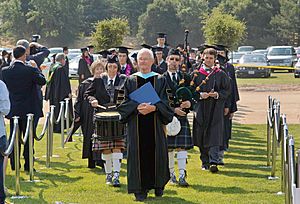Portola Valley, California facts for kids
Quick facts for kids
Portola Valley, California
|
||
|---|---|---|
| Town of Portola Valley | ||
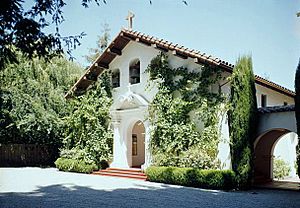
|
||
|
||
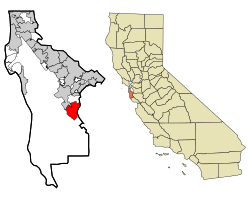
Location in San Mateo County and the state of California
|
||
| Country | United States | |
| State | California | |
| County | San Mateo | |
| Incorporated | July 14, 1964 | |
| Named for | Gaspar de Portolá | |
| Area | ||
| • Total | 9.08 sq mi (23.53 km2) | |
| • Land | 9.08 sq mi (23.52 km2) | |
| • Water | 0.00 sq mi (0.00 km2) 0.02% | |
| Elevation | 459 ft (140 m) | |
| Population
(2020)
|
||
| • Total | 4,456 | |
| • Density | 490.7/sq mi (189.38/km2) | |
| Time zone | UTC-8 (PST) | |
| • Summer (DST) | UTC-7 (PDT) | |
| ZIP code |
94028
|
|
| Area code | 650 | |
| FIPS code | 06-58380 | |
| GNIS feature ID | 1659786 | |
Portola Valley is a town in San Mateo County, California, United States. It is located on the San Francisco Peninsula in the Bay Area. Portola Valley is a small community found on the eastern slopes of the Santa Cruz Mountains.
Contents
History of Portola Valley
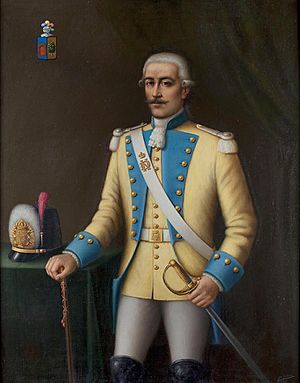
Portola Valley gets its name from Gaspar de Portolá. He was a Spanish explorer who led the first group of Europeans to explore the San Francisco Peninsula in 1769.
Native American groups, like the Ohlone, lived here first. Later, they moved to nearby missions. The written history of the area began in 1833. That's when a large piece of land was given to Domingo Peralta and Máximo Martínez. This land was called Rancho Cañada del Corte de Madera. People used it for cutting lumber and raising cattle.
In the 1880s, Andrew S. Hallidie built his home, Eagle Home Farm, in what is now Portola Valley. He was known for making wire ropes. In 1894, he built a very long cable car system, over 7,000 feet long. It went from his house to the top of Skyline. This system was removed after he passed away in 1900.
In 1886, the area was named Portola-Crespi Valley. Crespi is for Juan Crespí, a friar who was with the Portolá expedition.
The town officially became a town in 1964. Bill Lane, who was the publisher of Sunset magazine, became its first mayor.
In recent years, the town has faced challenges. In 2023, many government workers left their jobs. This happened after some residents disagreed with plans to build more homes in the town. State law requires Portola Valley to allow 253 new homes to be built.
In March 2024, Portola Valley became the first California town to have its housing plans rejected by the state. This was because the town had not taken the necessary steps to allow for more affordable housing. Also in 2024, the town faced money problems. These issues came from the high costs of hiring consultants and legal fees from lawsuits. Some people even thought about joining Portola Valley with the county or a nearby city.
Geography of the Town
Portola Valley is on the San Francisco Peninsula. It sits on the eastern side of the Santa Cruz Mountains. The town is west of Interstate 280. Its southwest edge is along Skyline Boulevard, which follows the mountain ridge.
Windy Hill Open Space Preserve covers a large part of the town's southwest side. The north side borders Jasper Ridge Biological Preserve. Woodside is to the northwest, and Palo Alto is to the southeast. The area is mostly wooded, with some open fields. The San Andreas Fault, a major earthquake fault line, runs through the town.
Alpine Road and Portola Road are the two main roads in town. Where they meet, there is a small area with shops.
Portola Valley is divided into seven main areas. These include Central Portola Valley, The Ranch, and Corte Madera. Other areas are Los Trancos/Vista Verde, Woodside Highlands, Westridge, and Blue Oaks.
The town covers about 9.1 square miles (23.5 square kilometers). Almost all of this area is land.
Attractions and Fun Places
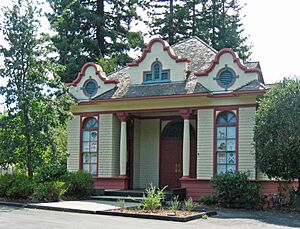
Our Lady of the Wayside Church was built in 1912 for the local Catholic community. It is a California Historic Landmark and is listed on the U.S. National Register of Historic Places.
The Portola Valley School is a historic one-room schoolhouse built in 1909. It is also on the U.S. National Register of Historic Places. Today, it is used for town council meetings.
The Alpine Inn, also known as Casa de Tableta or Zott's, is one of California's oldest places to get a drink. It started around 1852 as a gambling house. In 1976, a special van parked next to the Alpine Inn. From there, the first two-network TCP/IP message was sent to the ARPANET. The inn was bought by new owners in 2018 and reopened in 2019 after renovations.
Trails for Exploring
Portola Valley is famous for its many trails. These trails are maintained by the town and by the Midpeninsula Regional Open Space District. The trail system includes the 235-acre Coal Mine Ridge Nature Preserve. This preserve is private land but is kept as open space for everyone to enjoy.
Population and People
| Historical population | |||
|---|---|---|---|
| Census | Pop. | %± | |
| 1970 | 4,996 | — | |
| 1980 | 3,939 | −21.2% | |
| 1990 | 4,194 | 6.5% | |
| 2000 | 4,462 | 6.4% | |
| 2010 | 4,353 | −2.4% | |
| 2020 | 4,456 | 2.4% | |
| U.S. Decennial Census | |||
In 2020, Portola Valley had a population of 4,456 people. Most residents are white, making up about 75% of the population. This is higher than the average for San Mateo County. The town has rules that mostly allow only single-family homes. This means there are fewer apartments or multi-family buildings.
In 2020, the average income for a household in Portola Valley was about $235,469 per year. The average income per person was about $142,778.
Population in 2010
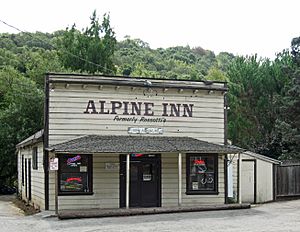
The 2010 Census showed that Portola Valley had 4,353 people. About 91% of the people were White. About 5.6% were Asian, and 4% were Hispanic or Latino.
Most people, about 99%, lived in homes. There were 1,746 households in total. About 30% of these households had children under 18. The average household had 2.47 people.
The population included 23% under 18 years old. About 27% were 65 years or older. The average age in Portola Valley was 51.3 years.
Housing in Portola Valley
In 2024, the average cost of a home in Portola Valley was about $3.8 million. More than 81% of the homes are single-family houses. These homes often sit on lots larger than one acre.
Education and Schools
The Portola Valley Elementary School District has two public elementary schools. Ormondale School serves grades K-3. Corte Madera School serves grades 4-8. For high school, students attend Woodside High School. This school is part of the Sequoia Union High School District and is in the nearby town of Woodside. Ormondale School is named after a ranch that used to be in the area.
Portola Valley also has two private schools. Woodside Priory School is a Catholic school for grades 6-12. Woodland School is for students from pre-kindergarten to 8th grade.
The town's public library is the Portola Valley Public Library. It is part of the San Mateo County Libraries system.
Notable People from Portola Valley
- John Arrillaga, a billionaire businessman.
- Pat Burrell, a retired baseball player.
- Roger Craig, a retired professional football player.
- John Donahoe, CEO of Nike.
- Donna Dubinsky, former CEO of Palm, Inc..
- Taylor Eigsti, a jazz pianist.
- Dr. Thomas J. Fogarty, a surgeon and inventor.
- Tennessee Ernie Ford, a famous singer.
- Reid Hoffman, co-founder of LinkedIn.
- Vinod Khosla, co-founder of Sun Microsystems.
- Laurence W. "Bill" Lane Jr., the first mayor of Portola Valley. He was also an ambassador.
- Chong Moon Lee, founder of Diamond Multimedia.
- Jacques Littlefield, founder of a large collection of military vehicles.
- Pete McCloskey, a former member of Congress.
- Scott McNealy, co-founder of Sun Microsystems.
- Kent Mitchell, an Olympic rowing champion and former mayor.
- Ed Oates, a co-founder of Oracle Corporation.
See also
 In Spanish: Portola Valley para niños
In Spanish: Portola Valley para niños




